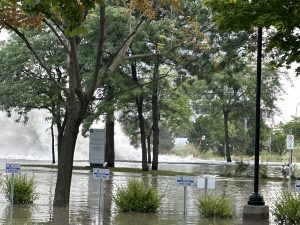We have, in the last few years, become more aware of the concept of resilience, the notion that we can build our communities so that they can survive devastating storms, floods or other natural disasters.
It also means building so that we can maintain livable conditions when the services we usually rely on are not available.
It’s an idea that we and our political leaders should be talking more about. Resilience is important. That’s why I make it a point to read the blog posts of Alex Wilson.
Wilson, a New Englander, founded both the Resilient Design Institute (a non-profit), and Building Green, Inc. He’s a consultant, an author and a speaker. He also writes an informative blog where recently he gave us all a history lesson.
If you’ve ever flown into Boston you’ll know that Logan airport is across the harbour from the downtown core. But did you know that the land Logan sits on was, as recently as the 1930s, a tidal flat? Or that in its early history, the area that is now downtown Boston was an island that was connected to the mainland by a thin land bridge?
Wilson put his history lesson together from two books: Bunker Hill, by Nathaniel Philbrick, and Gaining Ground: A History of Landmaking in Boston, by Nancy Seasholes.
"The earthmoving in Boston began in the 1700s," Wilson writes, "with picks, shovels and hand-pushed carts."
It took a lot of fill to convert Back Bay and South Bay to land that could be compacted, then built upon. At first, contractors simply cannibalized the hills in the city, including Beacon Hill. So much fill was taken from it that its height dropped by about 60 feet and the monument on top had to be relocated. Eventually, contractors had to look elsewhere, and an old photo accompanying Wilson’s blog shows a gravel train being loaded sometime in the 1860s in Needham, a community well outside the city then, although it is now a part of the Boston urban agglomeration.
He devotes quite a bit of space to describing the task of "raising" parts of the city.
Briefly, workers filled basements, then elevated buildings on cribbing, then built new foundations beneath them.
In one area, in 1868-69, contractors brought in more than 150,000 cubic yards of fill, then raised 296 brick buildings by as much as 14 feet and 56 wooden buildings by as much as 17 feet.
All that work took 15 months and was completed ahead of schedule and under budget. A similar project nearby used almost 250,000 yards of fill and 600 buildings were elevated — also under budget.
Wilson points out that there have been other landmaking projects. On Manhattan Island, "several thousand acres of land were created using fill, and more than 3,000 acres were created in Chicago."
Could similar jobs be done today, faced as we are with rising ocean levels that will swamp many low-lying areas?
Large chunks of Miami, for example, will be drowned out unless drastic measures are taken.
Wilson isn’t suggesting that landmaking is the answer, noting that sea-level rise is inextricably linked to global warming.
In reply to a comment on his blog, he wrote that he wasn’t suggesting landmaking as a way to avoid addressing climate change.
But, he wrote, "I’m suggesting that over the next hundred years, in some low-lying cities, elevating buildings and raising the ground level in a co-ordinated fashion may be worth considering."
"We absolutely need to continue doing everything in our power to halt emissions of carbon dioxide and other greenhouse gases, but we also need to think about the reality of dramatic sea-level rise in the lifetimes of our children and grandchildren."
You can see all of Wilson’s blog post, along with some wonderful old photos, by visiting the Resilient Design Institute’s website at www.resilientdesign.org.
Korky Koroluk is an Ottawa-based freelance writer. Send comments to editor@journalofcommerce.com.











Recent Comments
comments for this post are closed